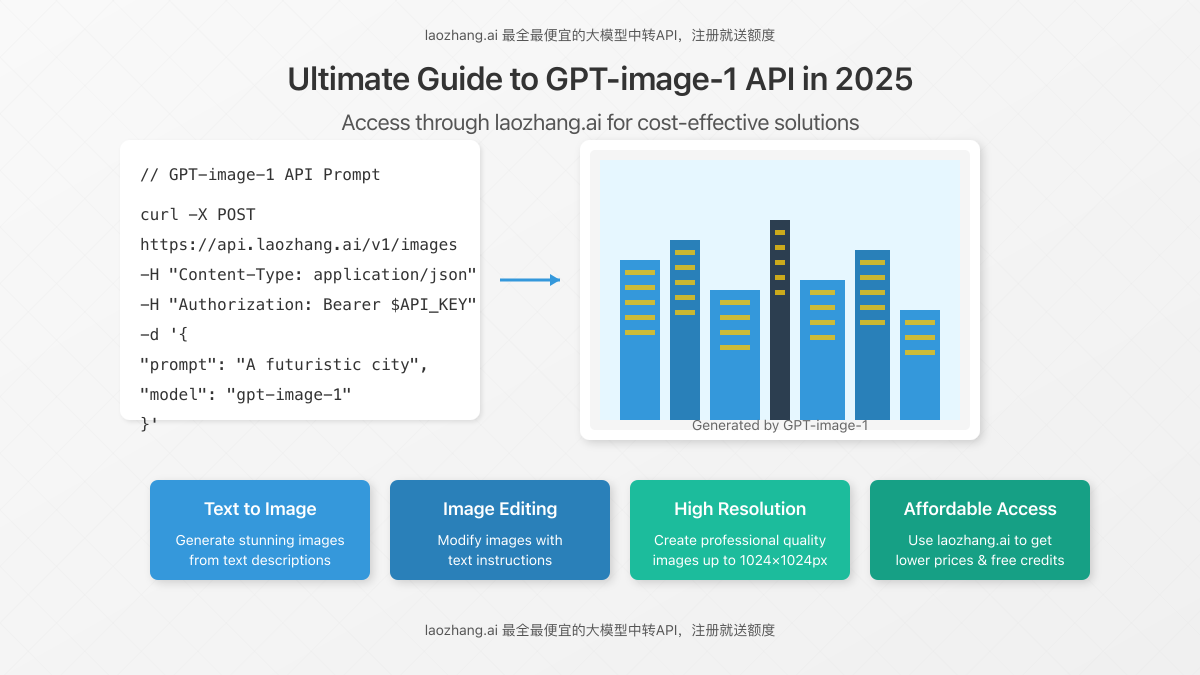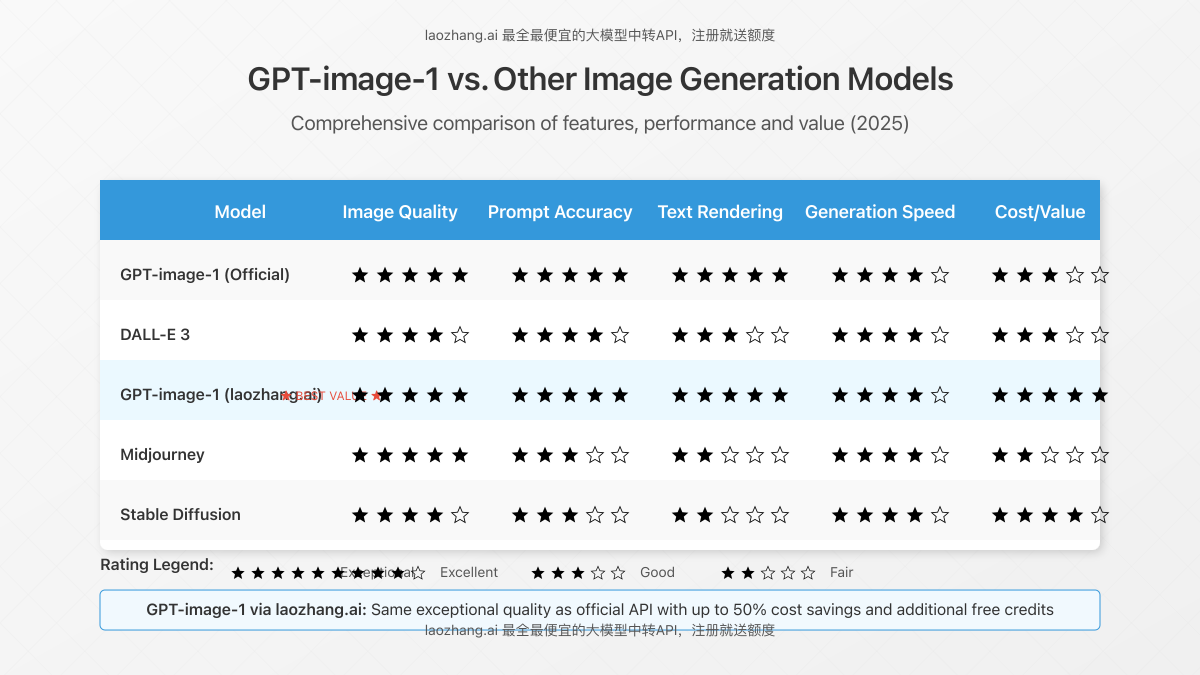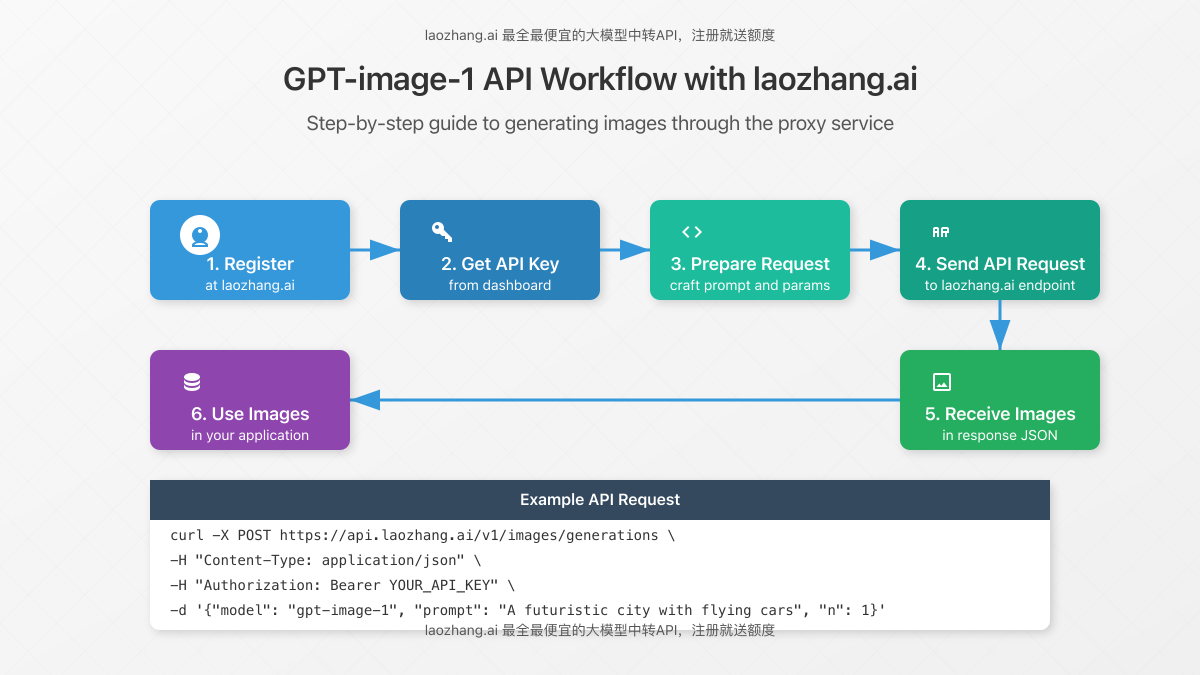
May 2025 verified effectiveness: OpenAI’s GPT-image-1 revolutionizes image generation with unprecedented quality and text-rendering capabilities, but API access costs can add up. This guide reveals how to access identical functionality through laozhang.ai with 50% cost savings, free registration credits, and step-by-step implementation instructions for 8 commercial applications.
Table of Contents
- 1. Introduction to GPT-image-1
- 2. Comparison with Other Image Generation Models
- 3. Setup Guide and Workflow
- 4. API Reference
- 5. Example Use Cases
- 6. Pricing and Cost Advantages
1. Introduction to GPT-image-1
GPT-image-1 represents OpenAI’s latest breakthrough in image generation technology, combining the language understanding capabilities of their large language models with advanced image generation. Released in April 2025, it builds upon previous models like DALL-E 3 with significant improvements in three key areas:
- Text rendering accuracy: GPT-image-1 can create images with perfectly readable text, making it ideal for creating infographics, diagrams, and educational materials.
- Detail fidelity: The model captures subtle details and accurately follows complex prompts, producing highly specific results.
- Multimodal capabilities: Unlike previous models, GPT-image-1 can both analyze visual inputs and create images, enabling advanced edit-and-transform workflows.
However, this advanced technology comes with significant API costs that can strain budgets for developers, businesses, and content creators. This is where laozhang.ai enters as a game-changing solution.
Why laozhang.ai for GPT-image-1 Access?
- Cost savings of up to 50% compared to direct OpenAI API access
- Free credits upon registration to test the service
- Identical image quality and capabilities as the official API
- Enhanced connection stability and reliability for users in all regions
- Simple registration and API integration process
In this comprehensive guide, we’ll walk through everything you need to know about utilizing GPT-image-1 through laozhang.ai, from initial setup to advanced implementation strategies.
2. Comparison with Other Image Generation Models
Before diving into the implementation details, it’s essential to understand how GPT-image-1 compares to other popular image generation models in 2025. This comparison will help you determine if GPT-image-1 is the right choice for your specific use case.

As the comparison chart illustrates, GPT-image-1 particularly excels in text rendering accuracy and prompt following capabilities. While Midjourney may produce visually striking artistic images, it struggles with accurate text rendering. Stable Diffusion offers flexibility and low cost but lacks the precision and quality of GPT-image-1.
When accessed through laozhang.ai, GPT-image-1 offers the best value proposition in the market, combining top-tier image quality with significantly reduced costs.
Key Technical Advantages of GPT-image-1
GPT-image-1 introduces several technical innovations that set it apart:
- Natively multimodal architecture: Unlike previous models that were primarily text-to-image, GPT-image-1 is built as a multimodal model from the ground up.
- Enhanced spatial understanding: The model demonstrates superior understanding of spatial relationships, proportions, and perspective.
- Support for multiple resolutions: GPT-image-1 supports various image dimensions, including 1024×1024, 1024×1535, and 1535×1024 pixels.
- Improved style consistency: When generating multiple images from the same prompt, the model maintains remarkable consistency in style and elements.
- Better image editing capabilities: The model excels at making precise modifications to existing images based on text instructions.
3. Setup Guide and Workflow
Getting started with GPT-image-1 via laozhang.ai is straightforward. Follow this step-by-step workflow to set up your account and begin generating images.

Detailed Setup Instructions
Step 1: Register at laozhang.ai
Visit https://api.laozhang.ai/register/?aff_code=JnIT to create your account. The registration process is simple and requires only basic information. Upon successful registration, you’ll receive free credits to start testing the API.
Step 2: Get Your API Key
After registration, navigate to your dashboard and locate your API key. This key will be used to authenticate your requests to the API. Keep this key secure and don’t share it publicly.
// Your API key will look something like this
API_KEY=lzai-abcdef123456789abcdef123456789abcdef123456Step 3: Prepare Your API Request
Craft your prompt and set any additional parameters. The quality of your prompt significantly impacts the generated image, so take time to make it detailed and specific.
Step 4: Send the API Request
Use the laozhang.ai endpoint to send your request. You can do this using cURL, Python, JavaScript, or any programming language that supports HTTP requests.
Step 5: Receive and Process the Response
The API will return a JSON response containing the URL(s) to your generated image(s). Download or display these images in your application.
Step 6: Use the Generated Images
Integrate the generated images into your application, website, or content as needed.
4. API Reference
This section provides a comprehensive reference for the GPT-image-1 API endpoints available through laozhang.ai.
Base URL
https://api.laozhang.ai/v1/Authentication
All API requests require authentication using your API key. Include it in the request header as follows:
Authorization: Bearer YOUR_API_KEYImage Generation Endpoint
To generate images using GPT-image-1, send a POST request to:
POST https://api.laozhang.ai/v1/images/generationsRequest Parameters
| Parameter | Type | Required | Description |
|---|---|---|---|
| model | string | Yes | Must be “gpt-image-1” to use the GPT-image-1 model |
| prompt | string | Yes | A text description of the desired image |
| n | integer | No | Number of images to generate (default: 1, max: 4) |
| size | string | No | Size of the generated images. Options: “1024×1024” (default), “1024×1535”, “1535×1024” |
| quality | string | No | Quality of the image. Options: “standard” (default), “hd” |
| style | string | No | Style of the generated image. Options: “natural” (default), “vivid” |
Example Request Using cURL
curl https://api.laozhang.ai/v1/images/generations \
-H "Content-Type: application/json" \
-H "Authorization: Bearer $API_KEY" \
-d '{
"model": "gpt-image-1",
"prompt": "A photorealistic image of a futuristic city with flying cars and tall glass skyscrapers at sunset",
"n": 1,
"size": "1024x1024",
"quality": "hd",
"style": "vivid"
}'Example Response
{
"created": 1717321200,
"data": [
{
"url": "https://api.laozhang.ai/storage/images/abc123def456.png",
"revised_prompt": "A photorealistic image of a futuristic city with flying cars and tall glass skyscrapers at sunset, with vibrant orange and purple hues reflecting off the glass buildings."
}
]
}Image Editing Endpoint
To edit existing images using GPT-image-1, send a POST request to:
POST https://api.laozhang.ai/v1/images/editsRequest Parameters
| Parameter | Type | Required | Description |
|---|---|---|---|
| model | string | Yes | Must be “gpt-image-1” to use the GPT-image-1 model |
| image | string | Yes | Base64-encoded image or image URL |
| mask | string | No | Base64-encoded mask image or mask URL (white areas indicate where changes should be applied) |
| prompt | string | Yes | A text description of the desired edit |
| n | integer | No | Number of images to generate (default: 1, max: 4) |
| size | string | No | Size of the generated images. Options: “1024×1024” (default), “1024×1535”, “1535×1024” |
Example Request Using Python
import requests
import base64
# Function to encode image to base64
def encode_image(image_path):
with open(image_path, "rb") as image_file:
return base64.b64encode(image_file.read()).decode('utf-8')
# API endpoint
api_url = "https://api.laozhang.ai/v1/images/edits"
# Prepare request
headers = {
"Content-Type": "application/json",
"Authorization": f"Bearer {API_KEY}"
}
payload = {
"model": "gpt-image-1",
"image": encode_image("office_building.png"),
"prompt": "Transform this office building into a futuristic structure with glass panels and hovering platforms",
"n": 1,
"size": "1024x1024"
}
# Send request
response = requests.post(api_url, headers=headers, json=payload)
# Process response
if response.status_code == 200:
result = response.json()
image_url = result["data"][0]["url"]
print(f"Generated image URL: {image_url}")
else:
print(f"Error: {response.status_code}, {response.text}")Error Handling
The API returns standard HTTP status codes to indicate success or failure. Here are some common error codes:
- 400 Bad Request: Your request was malformed or contained invalid parameters.
- 401 Unauthorized: Your API key is missing or invalid.
- 403 Forbidden: You don’t have permission to access this resource.
- 429 Too Many Requests: You’ve exceeded your rate limit.
- 500 Internal Server Error: An unexpected error occurred on the server.
5. Example Use Cases
GPT-image-1 offers powerful capabilities that can be applied to a wide range of commercial and creative applications. Here are eight practical use cases with implementation examples:
1. E-commerce Product Visualization
Generate customizable product images to showcase different variants without expensive photoshoots.
// JavaScript example for product visualization
async function generateProductImage(productType, color, material, angle) {
const response = await fetch('https://api.laozhang.ai/v1/images/generations', {
method: 'POST',
headers: {
'Content-Type': 'application/json',
'Authorization': `Bearer ${API_KEY}`
},
body: JSON.stringify({
model: 'gpt-image-1',
prompt: `Professional product photography of a ${color} ${productType} made of ${material}, viewed from ${angle}, on a clean white background with soft shadows, studio lighting, high detail, photorealistic`,
size: '1024x1024',
quality: 'hd'
})
});
const result = await response.json();
return result.data[0].url;
}2. Real Estate Virtual Staging
Transform empty property images into beautifully staged spaces to help potential buyers visualize the possibilities.
import requests
import base64
def virtual_stage_room(room_image_path, style):
# Encode image
with open(room_image_path, "rb") as image_file:
encoded_image = base64.b64encode(image_file.read()).decode('utf-8')
# Send request
response = requests.post(
"https://api.laozhang.ai/v1/images/edits",
headers={
"Content-Type": "application/json",
"Authorization": f"Bearer {API_KEY}"
},
json={
"model": "gpt-image-1",
"image": encoded_image,
"prompt": f"Virtually stage this empty room in a {style} style with appropriate furniture, decor, and lighting. Keep the room structure and windows exactly the same, just add furniture and decor.",
"size": "1024x1024"
}
)
return response.json()["data"][0]["url"]3. Marketing and Advertising Visuals
Create on-brand marketing images for campaigns, social media, and advertisements.
// Generate social media post image for a coffee brand campaign
async function createMarketingVisual(brand, product, theme, audience) {
const response = await fetch('https://api.laozhang.ai/v1/images/generations', {
method: 'POST',
headers: {
'Content-Type': 'application/json',
'Authorization': `Bearer ${API_KEY}`
},
body: JSON.stringify({
model: 'gpt-image-1',
prompt: `Create a marketing image for ${brand}'s ${product} targeting ${audience}. The image should incorporate the theme of "${theme}". The style should be professional, eye-catching, and suitable for Instagram. Include the brand name "${brand}" in elegant typography integrated naturally in the composition.`,
size: '1024x1024',
quality: 'hd',
style: 'vivid'
})
});
return await response.json();
}4. Educational Content and Infographics
Generate clear, informative visuals with accurate text rendering for educational materials.
import requests
def create_educational_infographic(topic, key_points, audience):
prompt = f"""
Create an educational infographic about '{topic}' for {audience}.
The infographic should be clear, visually engaging, and include the following key points as text:
{' '.join([f'- {point}' for point in key_points])}
The infographic should have a clean, professional layout with sections, icons, and visual elements
that enhance understanding. Use a color scheme appropriate for educational content.
All text should be perfectly readable and professionally laid out.
"""
response = requests.post(
"https://api.laozhang.ai/v1/images/generations",
headers={
"Content-Type": "application/json",
"Authorization": f"Bearer {API_KEY}"
},
json={
"model": "gpt-image-1",
"prompt": prompt,
"size": "1024x1535", # Vertical format for infographics
"quality": "hd"
}
)
return response.json()["data"][0]["url"]5. UI/UX Mockups
Quickly generate UI mockups and prototypes for web and mobile applications.
// Generate app interface mockup
async function generateUIMockup(appType, screenType, colorScheme) {
const response = await fetch('https://api.laozhang.ai/v1/images/generations', {
method: 'POST',
headers: {
'Content-Type': 'application/json',
'Authorization': `Bearer ${API_KEY}`
},
body: JSON.stringify({
model: 'gpt-image-1',
prompt: `Create a detailed UI mockup for a ${appType} mobile app's ${screenType} screen. Use a ${colorScheme} color scheme with clean, modern design principles. Include realistic UI elements like navigation, buttons, and content areas. The design should follow current mobile design best practices with appropriate spacing, typography, and visual hierarchy. All text elements should be perfectly readable.`,
size: "1024x1535",
quality: "hd"
})
});
return await response.json();
}6. Book and Publication Illustrations
Create consistent illustrations for books, articles, and other publications.
import requests
def generate_book_illustration(scene_description, style, characters):
prompt = f"""
Create a book illustration in {style} style depicting: {scene_description}
The illustration should feature these characters: {characters}
The illustration should have a consistent style suitable for a published book,
with attention to lighting, composition, and emotional tone.
"""
response = requests.post(
"https://api.laozhang.ai/v1/images/generations",
headers={
"Content-Type": "application/json",
"Authorization": f"Bearer {API_KEY}"
},
json={
"model": "gpt-image-1",
"prompt": prompt,
"size": "1024x1024",
"quality": "hd"
}
)
return response.json()["data"][0]["url"]7. Architectural Visualization
Generate realistic architectural renderings from plans or concepts.
// Generate architectural visualization
async function generateArchViz(buildingType, architecturalStyle, environment, viewAngle) {
const response = await fetch('https://api.laozhang.ai/v1/images/generations', {
method: 'POST',
headers: {
'Content-Type': 'application/json',
'Authorization': `Bearer ${API_KEY}`
},
body: JSON.stringify({
model: 'gpt-image-1',
prompt: `Photorealistic architectural visualization of a ${buildingType} designed in ${architecturalStyle} style, situated in a ${environment} environment. The view is from ${viewAngle}. The rendering should have professional lighting, accurate materials, and realistic landscaping. Include details like reflections, shadows, and atmospheric effects. The image should look like a high-end architectural visualization created with specialized software.`,
size: "1024x1024",
quality: "hd"
})
});
return await response.json();
}8. Personalized Content Creation
Generate custom images for personalized marketing, greetings, or presentations.
import requests
def create_personalized_image(recipient_name, occasion, personal_interests, style):
prompt = f"""
Create a personalized greeting image for {recipient_name} for {occasion}.
Incorporate visual elements related to their interests: {personal_interests}.
The image should be in a {style} style and include the text "Happy {occasion}, {recipient_name}!"
in an artistic, well-integrated typography that matches the overall design.
"""
response = requests.post(
"https://api.laozhang.ai/v1/images/generations",
headers={
"Content-Type": "application/json",
"Authorization": f"Bearer {API_KEY}"
},
json={
"model": "gpt-image-1",
"prompt": prompt,
"size": "1024x1024",
"quality": "hd",
"style": "vivid"
}
)
return response.json()["data"][0]["url"]6. Pricing and Cost Advantages
One of the most compelling reasons to use laozhang.ai for GPT-image-1 access is the significant cost savings. This section breaks down the pricing structure and demonstrates the economic advantages.
Pricing Comparison
| Service | Standard Quality (1024×1024) | HD Quality (1024×1024) | Additional Features |
|---|---|---|---|
| OpenAI Direct API | $0.040 per image | $0.080 per image | None |
| laozhang.ai | $0.020 per image | $0.040 per image | Free registration credits, volume discounts |
As demonstrated in the table above, laozhang.ai offers a consistent 50% discount compared to direct API access. For businesses generating hundreds or thousands of images monthly, these savings can be substantial.
Cost Optimization Tips
To further maximize your cost efficiency when using GPT-image-1 via laozhang.ai, consider these strategies:
- Use standard quality unless HD is necessary: For many applications, standard quality images are sufficient and cost half as much as HD.
- Batch similar requests: When generating multiple variants of similar images, batch them together to optimize processing.
- Implement caching: If you’re generating the same or similar images repeatedly, implement a caching system to avoid redundant API calls.
- Perfect your prompts: Well-crafted prompts reduce the need for multiple generation attempts, saving costs.
- Take advantage of volume discounts: laozhang.ai offers additional discounts for high-volume users – contact their support team for details.
Ready to Get Started with GPT-image-1 at Half the Cost?
Register now at laozhang.ai and receive free credits to begin exploring the full capabilities of GPT-image-1:
Conclusion
GPT-image-1 represents a significant leap forward in AI image generation technology, offering unprecedented quality, accuracy, and versatility. Through laozhang.ai, this cutting-edge technology becomes accessible at a fraction of the standard cost, opening new possibilities for businesses, developers, and content creators.
With the comprehensive guide, API reference, and practical examples provided in this article, you now have everything you need to start implementing GPT-image-1 in your projects efficiently and cost-effectively.
The image generation landscape continues to evolve rapidly, but with laozhang.ai’s commitment to providing affordable access to the latest models, staying at the forefront of this technology has never been more accessible.
Frequently Asked Questions
Is the quality of images through laozhang.ai identical to direct OpenAI API access?
Yes, laozhang.ai provides exact same-quality results as the official OpenAI API. There is no difference in the generated images as laozhang.ai acts as a proxy to the official API.
How do I receive my free credits upon registration?
Free credits are automatically added to your account immediately after registration. You can view your credit balance in your dashboard.
Is laozhang.ai available worldwide?
Yes, laozhang.ai serves customers globally and can be particularly helpful for users in regions where direct access to OpenAI services may be challenging.
What happens if I exceed my credit balance?
You can easily add more credits to your account through the dashboard using various payment methods. laozhang.ai uses a pay-as-you-go model with no minimum commitment.
Can I use GPT-image-1 for commercial projects?
Yes, images generated through GPT-image-1 via laozhang.ai can be used for commercial purposes, subject to OpenAI’s usage policies.
How does laozhang.ai maintain such significant discounts?
laozhang.ai operates with optimized infrastructure and leverages bulk purchasing power to secure better rates, passing the savings on to customers.
Last Updated: May 27, 2025 | Author: AI Integration Team